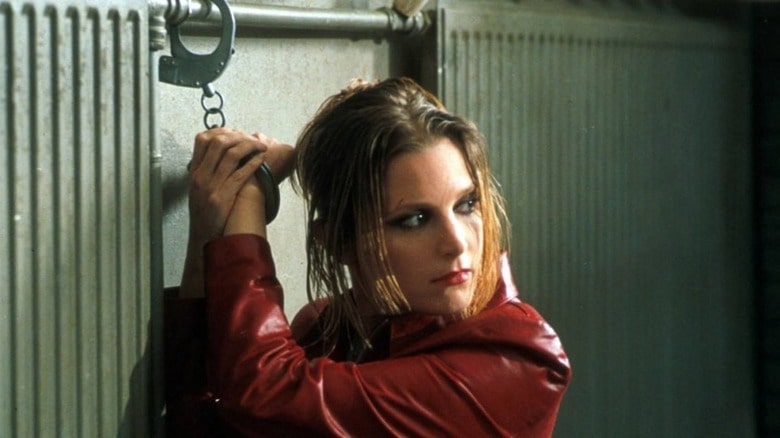With her quick wit, girl-next-door vibe, and a last name that screams “Hollywood legacy,” big-screen glory seemed a certainty for Bridget Fonda. And from the late ’80s into the ’90s, Fonda’s career was the very definition of glorious as she waltzed through arresting thrillers (Single White Female), warm-hearted rom-coms (It Could Happen To You), and genre fare (Frankenstein Unbound).
For more than a decade, Fonda had Tinseltown eating from the palm of her hand—and then she disappeared. Since 2002, Fonda hasn’t appeared in a single film or TV show. If you’re among the many fans wondering where she went, don’t worry: we dug up a few answers for you.

A simple case of too much, too soon

Fonda’s family name all but demanded a big-screen breakthrough. Yet while she made her debut at the ripe old age of five, as an uncredited role as one of the commune kids in Easy Rider, she didn’t really catch the acting bug until landing a role in a school production of Harvey. Fonda would go on to study drama at the Lee Strasberg Theater Institute and NYU’s Tisch School of the Arts, graduating in 1986 and walking right into the Hollywood high life.
Fonda’s first credited role came in the 1987 Cannes Film Fest favorite Aria. Her performance was lauded by critics and filmgoers alike, and the film proved Fonda’s first step toward stardom. Her profile continued to rise after strong supporting turns in the 1989 films Shag and Scandal, followed by 1990’s The Godfather III. Her turn in Doc Hollywood a year later proved she could handle comedy too.
The ‘it girl’ problem

Fonda’s hot streak continued through the early ’90s with roles in the hit thriller Single White Female and the acclaimed Cameron Crowe dramedy; add in her uncredited cameo in 1992’s Army Of Darkness, and it looked like there was no genre she couldn’t handle. She could play hip and cool, sweet and vulnerable, or smart and sexy with equal comfort. But she could also handle campy, blood-and-guts mayhem. And yes, she could draw solid box-office numbers too—Single White Female alone made nearly $50 million upon release.
With that sort of success, Fonda’s “it girl” status was unavoidable—and while it put her in some great early ’90s company alongside stars like Julia Roberts and Meg Ryan, it comes with lofty expectations. While Fonda continued to work steadily in the years that followed, the peaks (Point Of No Return, Jackie Brown) and valleys (The Road To Wellville, The Whole Shebang) proved too much to overcome. Her momentum slowed during the late ’90s—and as many other stars can attest, once your career cools off, it’s hard to heat it up again.
She worked a lot over a short period of time

We can wonder why she stepped back, but you can’t say Fonda didn’t make the most of her time in the spotlight. Between 1987 and 1998, she consistently made three to four films a year—more than 30 in all, over a relatively abbreviated period.
With that sort of workload it’s easy to imagine that Fonda simply burned out. And who could blame her? After all, every single one of those projects came with their own set of pre-production prep and post-production press—not to mention the time spent in production itself.
Fonda was basically working nonstop for 11 straight years. Frankly, the thought of that work schedule is enough to make even our heads spin. We can only imagine the effect it had on Fonda.
TV didn’t pan out

Television producers pursued Fonda for years—in fact, she actually turned down the lead role on Ally McBeal in 1999 so she could focus on making movies. It’s tough to second guess that decision—after all, Ally McBeal lasted five seasons, and didn’t exactly set its lead, Calista Flockhart, on the path to film stardom. But one can’t help but wonder if starring in a series might have done Fonda some good.
On the other hand, her television efforts didn’t really pan out. She took a supporting role in the brilliant but ratings-challenged Chris Isaak Show, and appeared in the TV movies No Ordinary Baby and Snow Queen. The latter release premiered in December of 2002, and Fonda hasn’t appeared in a film or television project since.
The Hollywood machine took its toll

Of course, Fonda may have had other reasons for walking away. Hollywood is not an easy town to work in if you’re a woman, and when you factor in the industry’s treatment of women past the age of 40, and add in the pressure of upholding a legacy, it isn’t hard to imagine that Bridget Fonda simply didn’t see much of a future for herself in acting.
She was 38 when she walked away from Hollywood in 2002, she already had 49 film and TV credits to her name, and had proven herself a talented performer and a box office draw. Why not leave the pressure vacuum of stardom behind before it left her?
And who’s to say that Bridget Fonda won’t find her way back to the red carpet one day as well? Hollywood loves a good comeback, and for proof, look no further than Bridget’s own father. After breaking through in the ’60s, the elder Fonda spent the better part of the ’70s, ’80s, and ’90s toiling away in middling B-movie fare. He didn’t break back into Hollywood’s good graces until his Oscar-nominated turn in 1997’s Ulee’s Gold.
In this new golden age of television, we’d like to think Bridget’s road back would be a little easier, and a challenging supporting role on a great Netflix or Amazon series might be just the ticket to get her back in front of cameras—though we’re sort of holding our breath that Elfman might pull a few strings to get her cast in one of the upcoming projects from his frequent collaborator, director Tim Burton. Like, say, Beetlejuice 2. Who wouldn’t want to see Fonda share the screen with Winona Ryder and Michael Keaton? Seriously, take our money now.




